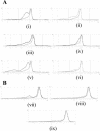Incidence and mechanism of ciprofloxacin resistance in Campylobacter spp. isolated from commercial poultry flocks in the United Kingdom before, during, and after fluoroquinolone treatment
- PMID: 15673754
- PMCID: PMC547197
- DOI: 10.1128/AAC.49.2.699-707.2005
Incidence and mechanism of ciprofloxacin resistance in Campylobacter spp. isolated from commercial poultry flocks in the United Kingdom before, during, and after fluoroquinolone treatment
Abstract
Five commercial broiler flocks were treated with a fluoroquinolone for a clinically relevant infection. Fresh feces from individual chickens and environmental samples were cultured for campylobacters before, during, and weekly posttreatment until slaughter. Both Campylobacter jejuni and C. coli were isolated during all treatment phases. An increased proportion of quinolone-resistant strains was seen during treatment, and these strains persisted posttreatment. One quinolone-resistant isolate of each species, each serotype, and each phage type from each sample at all treatment phases was examined for its phenotype and mechanism of resistance. Two resistant phenotypes were isolated: Nal(r) Cip(r) and Nal(r) Cip(s). The majority (269 of 290) of fluoroquinolone-resistant isolates, whether they were C. jejuni or C. coli, had a mutation in gyrA that resulted in the substitution Thr-86-->Ile. The other gyrA mutations detected were Thr-86-->Ala (n = 17) and Asp-90-->Asn (n = 10). The genotypic variation, based on the silent mutations in gyrA identified by the denaturing high-performance liquid chromatography pattern and DNA sequencing, was used to supplement typing data and provided evidence for both the spread of preexisting resistant strains and the selection of spontaneous resistant mutants in treated flocks. Multidrug resistance was significantly (P < 0.01) associated with resistance to ciprofloxacin. Twenty-five percent (73 of 290) of ciprofloxacin-resistant isolates but only 13% (24 of 179) of susceptible isolates were resistant to three or more unrelated antimicrobial agents. In conclusion, quinolone-resistant campylobacters were isolated from commercial chicken flocks in high numbers following therapy with a veterinary fluoroquinolone. Most ciprofloxacin-resistant isolates had the GyrA substitution Thr-86-->Ile. Resistant isolates were isolated from the feces of some flocks up to the point of slaughter, which may have consequences for public health.
Figures

Similar articles
-
Prevalence and subtypes of ciprofloxacin-resistant Campylobacter spp. in commercial poultry flocks before, during, and after treatment with fluoroquinolones.Antimicrob Agents Chemother. 2005 Feb;49(2):690-8. doi: 10.1128/AAC.49.2.690-698.2005. Antimicrob Agents Chemother. 2005. PMID: 15673753 Free PMC article.
-
A Study on Campylobacter jejuni and Campylobacter coli through Commercial Broiler Production Chains in Thailand: Antimicrobial Resistance, the Characterization of DNA Gyrase Subunit A Mutation, and Genetic Diversity by Flagellin A Gene Restriction Fragment Length Polymorphism.Avian Dis. 2017 Jun;61(2):186-197. doi: 10.1637/11546-120116-Reg.1. Avian Dis. 2017. PMID: 28665716
-
Mutant prevention concentrations of fluoroquinolones against Campylobacter jejuni isolated from chicken.Vet Microbiol. 2010 Aug 26;144(3-4):409-14. doi: 10.1016/j.vetmic.2010.02.020. Epub 2010 Feb 18. Vet Microbiol. 2010. PMID: 20226601
-
Fluoroquinolone resistance in campylobacter.J Food Prot. 2010 Jun;73(6):1141-52. doi: 10.4315/0362-028x-73.6.1141. J Food Prot. 2010. PMID: 20537275 Review.
-
Fluoroquinolone-resistant Campylobacter in animal reservoirs: dynamics of development, resistance mechanisms and ecological fitness.Anim Health Res Rev. 2003 Dec;4(2):63-71. doi: 10.1079/ahr200356. Anim Health Res Rev. 2003. PMID: 15134291 Review.
Cited by
-
Whole-Genome Sequencing-Based Profiling of Antimicrobial Resistance Genes and Core-Genome Multilocus Sequence Typing of Campylobacter jejuni from Different Sources in Lithuania.Int J Mol Sci. 2023 Nov 6;24(21):16017. doi: 10.3390/ijms242116017. Int J Mol Sci. 2023. PMID: 37958998 Free PMC article.
-
Fluoroquinolone use in food animals.Emerg Infect Dis. 2005 Nov;11(11):1789-90; author reply 1790-2. doi: 10.3201/eid1111.040630. Emerg Infect Dis. 2005. PMID: 16422004 Free PMC article. No abstract available.
-
Key role of Mfd in the development of fluoroquinolone resistance in Campylobacter jejuni.PLoS Pathog. 2008 Jun 6;4(6):e1000083. doi: 10.1371/journal.ppat.1000083. PLoS Pathog. 2008. PMID: 18535657 Free PMC article.
-
Growth kinetics and fitness of fluoroquinolone resistant and susceptible Campylobacter jejuni strains of cattle origin.Front Vet Sci. 2023 Apr 18;10:1117975. doi: 10.3389/fvets.2023.1117975. eCollection 2023. Front Vet Sci. 2023. PMID: 37143492 Free PMC article.
-
Antimicrobial Resistance in Campylobacter coli and Campylobacter jejuni from Human Campylobacteriosis in Taiwan, 2016 to 2019.Antimicrob Agents Chemother. 2022 Jan 18;66(1):e0173621. doi: 10.1128/AAC.01736-21. Epub 2021 Nov 8. Antimicrob Agents Chemother. 2022. PMID: 34748382 Free PMC article.
References
-
- Bachoual, R., S. Ouabdesselam, F. Mory, C. Lascols, C. J. Soussy, and J. Tankovic. 2001. Single or double mutational alterations of GyrA associated with fluoroquinolone resistance in Campylobacter jejuni and Campylobacter coli. Microb. Drug Resist. Mechanisms Epidemiol. Dis. 7:257-261. - PubMed
-
- Best, E. L., E. J. Powell, C. Swift, K. A. Grant, and J. A. Frost. 2003. Applicability of a rapid duplex real-time PCR assay for speciation of Campylobacter jejuni and Campylobacter coli directly from culture plates. FEMS Microbiol. Lett. 229:237-241. - PubMed
-
- Bolton, F. J., D. R. A. Wareing, M. B. Skirrow, and D. N. Hutchinson. 2001. Identification and biotyping of campylobacters, p. 151-161. In G. R. Board, D. Jones, and F. A. Skinner (ed.), Identification methods in applied and environmental microbiology. Blackwell Scientific Publications, Oxford, United Kingdom.
-
- Carattoli, A., A. Dionisi, and I. Luzzi. 2002. Use of a LightCycler gyrA mutation assay for identification of ciprofloxacin-resistant Campylobacter coli. FEMS Microbiol. Lett. 214:87-93. - PubMed
-
- Charvalos, E., E. Peteinaki, I. Spyridaki, S. Manetas, and Y. Tselentis. 1996. Detection of ciprofloxacin resistance mutations in Campylobacter jejuni gyrA by nonradioisotopic single-strand conformation polymorphism and direct DNA sequencing. J. Clin. Lab. Anal. 10:129-133. - PubMed
Publication types
MeSH terms
Substances
LinkOut - more resources
Full Text Sources
Medical
Molecular Biology Databases
Miscellaneous

